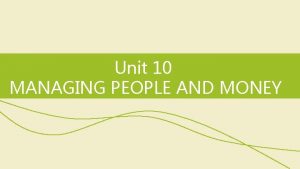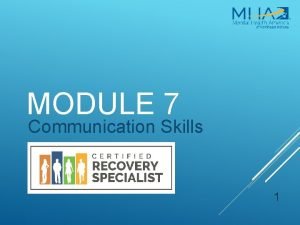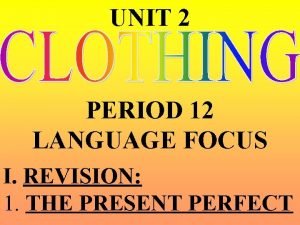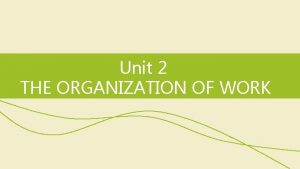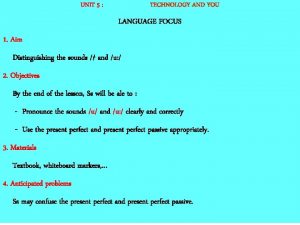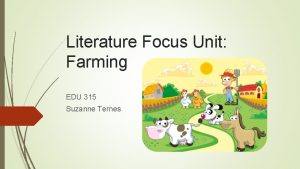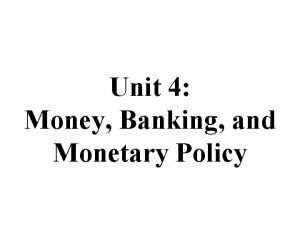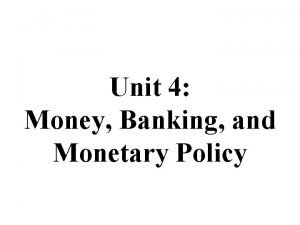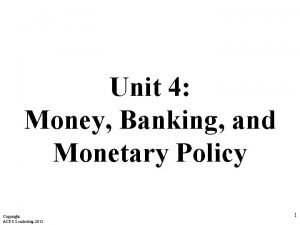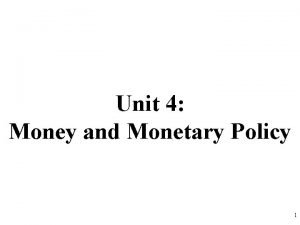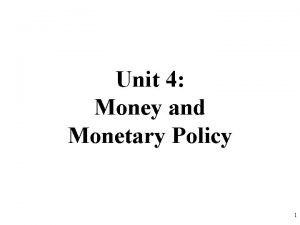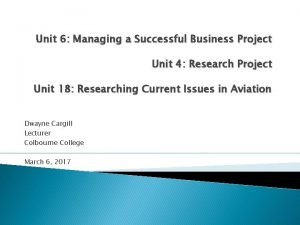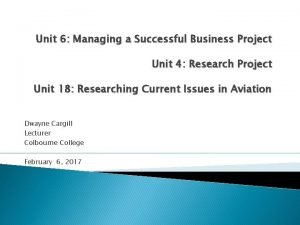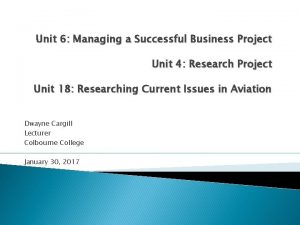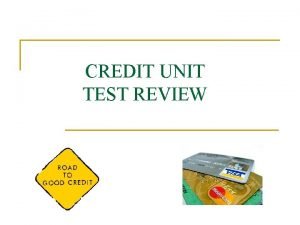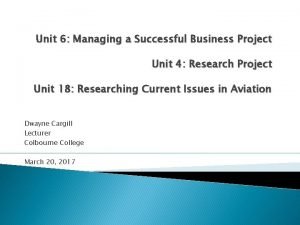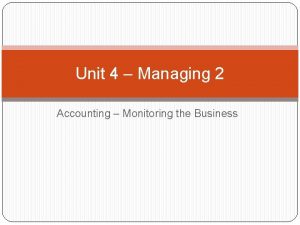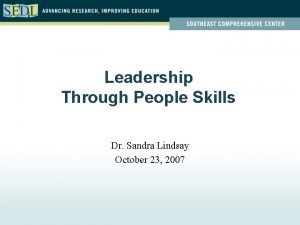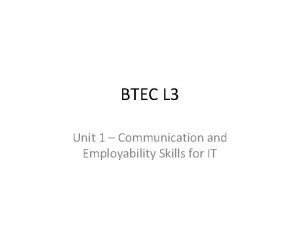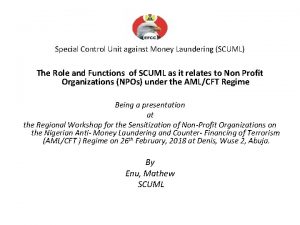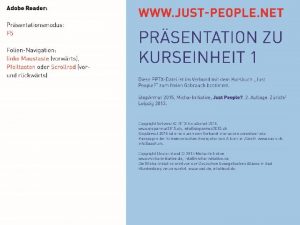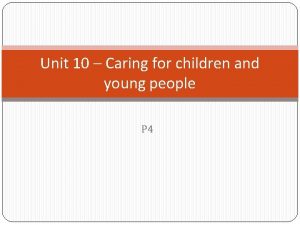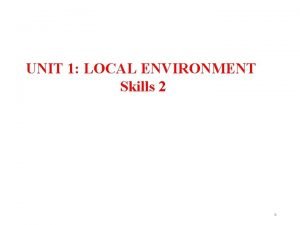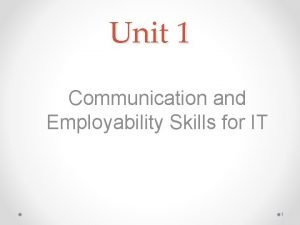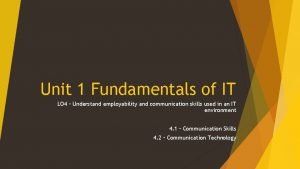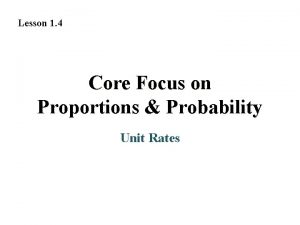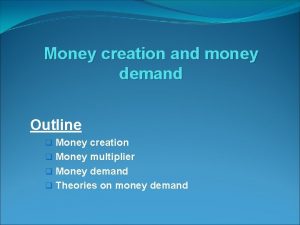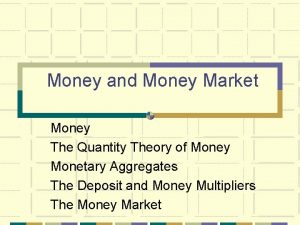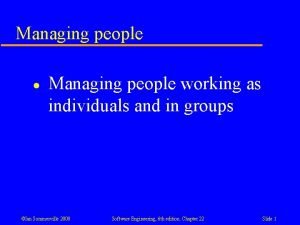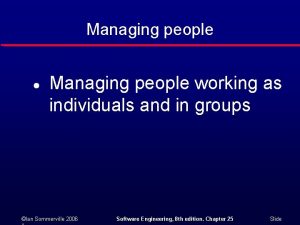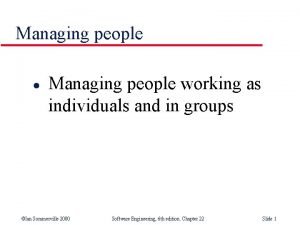Unit 10 MANAGING PEOPLE AND MONEY Skills focus
































































- Slides: 64

Unit 10 MANAGING PEOPLE AND MONEY

Skills focus Reading • recognizing the writer’s stance and level of confidence or tentativeness • inferring implicit ideas Writing • writing situation–problem– solution–evaluation essays • using direct quotations • Compiling a bibliography/ reference list Vocabulary focus • ‘neutral’ and ‘marked’ words • job titles (management/supervisory ) • fixed phrases from business management • fixed phrases from academic English

10. 1 Vocabulary 10. 2 Reading 10. 3 Extending skills 10. 4 Extending skills

10. 1 Vocabulary A Study the words in box a. 1 Use your dictionary to find out the meanings. 2 What part of speech is each word? Word Part of speech Meaning/synonym adopt v (T) start using, take up commitment n (C) an agreement, an obligation corporate adj relating to a (large) company empower v (T) give someone more control enhance v (T) implement v (T), n (C) operational adj improve (v) put into effect (n) tool relating to the day-to-day management of a business or other organization

10. 1 Vocabulary A Study the words in box a. 1 Use your dictionary to find out the meanings. 2 What part of speech is each word? Word Part of speech Meaning/synonym perform v (I, T) 1. do something (well) 2. work or function 3. entertain people (e. g. , in a play) productivity n (U) efficiency in terms of how quickly goods are produced or services are provided strategic adj tactical adj relating to the long-term needs of an organization relating to the medium- or short-term needs of an organization

10. 1 Vocabulary B Read the Hadford University handout. 1 Use your dictionary or another source to check the meanings of the highlighted phrases. 2 Which are the stressed syllables in each phrase? See Vocabulary bank.

Vocabulary bank Recognizing fixed phrases from tourism and hospitality studies (3) Make sure you understand these key phrases from finance. top-down management style process-oriented management style strategic decision tactical decision operational decision business strategy business interests long-term

Vocabulary bank Recognizing fixed phrases from tourism and hospitality studies (3) Make sure you understand these key phrases from finance. medium-term short-term human resources management team senior manager line manager employee involvement

10. 1 Vocabulary B Read the Hadford University handout. 1 Use your dictionary or another source to check the meanings of the highlighted phrases. process-oriented focused on processes, regulations, structures operating systems the systems (organizational structures, rules, etc. ) a company works by performance-driven focused on people delivering results decisions are taken by a management team and handed down to the workers the interests of a company top-down business interests employee involvement the degree to which employees are involved in decision making human resources the employees of a company long-term focused on results over a longer period of time

10. 1 Vocabulary B Read the Hadford University handout. 2 Which are the stressed syllables in each phrase? process-oriented Oo Oooo operating systems Oooo Oo performance-driven o. Oo Oo top-down o. O business interests Oo Oo employee involvement o. Oo human resources Oo o. Oo (Br. E) Oo Ooo (Am. E) long-term Oo

10. 1 Vocabulary C Look at the pictures on the opposite page. 1 Who are the people in each picture? What kind of organization do they work for? 2 Describe which role in the organization these people fulfil. These people all work in/for a hotel. 1 front office supervisor 2 food and beverages manager 3 executive chef 4 financial controller 5 executive housekeeper 6 maintenance manager

10. 1 Vocabulary financial controller C Look at the pictures on the opposite page. 3 Indicate where they would be on the organization chart. food and bev manager maintenance manager executive housekeeper executive chef front office supervisor

10. 1 Vocabulary D Study the words in box b. 1 Check the meanings, parts of speech and stress patterns. 2 Put the words into the correct box in the table below, as in the example. Neutral Marked rise, increase rocket, soar (v) fall, decrease big, large good small See Vocabulary bank.

Vocabulary bank Recognizing ‘marked’ words Many common words in English are ‘neutral’, i. e. , they do not imply any view on the part of the writer or speaker. However, there are often apparent synonyms which are ‘marked’. They show attitude, or stance. Examples: Occupancy rates rose by 10% last year. (neutral) Occupancy rates soared by 10% last year. (marked) Soared is marked because it implies that this is a particularly big or fast increase.

Vocabulary bank Recognizing ‘marked’ words When you read a sentence, think: Is this a neutral word, or is it a marked word? If it is marked, what does this tell me about the writer’s attitude to the information? When you write a sentence, think: Have I used neutral words or marked words? If I have used marked words, do they show my real attitude/the attitude of the original writer?

Vocabulary bank Recognizing ‘marked’ words Extend your vocabulary by learning marked words and their exact effect. Examples: Neutral Marked go down, fall, decrease slump, plummet say, state assert, maintain, claim, argue, allege good great, brilliant, tremendous

10. 1 Vocabulary D Study the words in box b. 1 Check the meanings, parts of speech and stress patterns. 2 Put the words into the correct box in the table below, as in the example. Neutral Marked rise, increase 'rocket, soar (v) fall, decrease co'llapse (v and n), 'plummet (v), slump (v and n) big, large e'normous, huge, 'massive, sig'nificant, tre'mendous* (adj) good 'brilliant, fan'tastic, great, out'standing, su'perb, tre'mendous*(adj) insig'nificant, 'minimal, 'minor (adj) small * Tremendous can mean both very large and very good, so it may be placed in either category.

10. 1 Vocabulary E Read the extract from a chairman’s letter to shareholders. 1 Use a marked word in place of each of the italic (neutral) words. rising soaring/rocketing large enormous/huge/massive good fantastic/superb/tremendous fall collapse/slump

10. 1 Vocabulary E Read the extract from a chairman’s letter to shareholders. 2 Look at the bold phrases. How strong or confident are they? See Skills bank.

Vocabulary bank Recognizing levels of confidence in research or information In an academic context, writers will usually indicate the level of confidence in information they are giving. When you read a ‘fact’ in a text, look for qualifying words before it, which show the level of confidence. Examples: It appears to be the case that … /This suggests that … (tentative) The evidence shows that … /It is clear that … (definite /confident)

10. 1 Vocabulary E Read the extract from the Cheapco chairman’s letter to shareholders. 2 Look at the bold phrases. How strong are they? Very confident Fairly confident It’s generally accepted now that √ It’s fair to say that √ We may start to introduce changes You can be confident, however, that Tentative ( = not confident) √ √

10. 2 Reading A Study the sentence on the right. Each phrase in box a could go in the space. What effect would each one have on the base meaning? Mark from *** = (very confident to) * = (very tentative). ** * *** **

10. 2 Reading B Survey the text on the opposite page. 1 What will the text be about? 2 Write three research questions.

10. 2 Reading C Read the text. Does it answer your questions?

10. 2 Reading D Answer these questions. 1 What level of decision-making is involved when a company decides to merge with another? Strategic. 2 A tour operator decides to try to buy extra rooms for one season only. What kind of aim is this? Medium-term/tactical. 3 What is the opposite of a top-down management style? Bottom-up.

10. 2 Reading D Answer these questions. 4 What reason does Murphy give for the need for good management? To ensure that any tourism product is both accepted by the community and profitable/competitive. 5 What does Page believe is the main objective of most tourism producers? Profit. 6 What is Leiper’s case study an example of? Empowerment management strategy. 7 Who has to change in Buhalis and Costa’s ‘transformations’? Everyone (workers and managers).

10. 2 Reading E Find the phrases in box b in the text. Is the writer confident (C) or tentative (T) about the information which follows? It is obvious, therefore, that successful businesses have to be good at finding sources of finance. C Many writers seem to agree that a difference should be made between internal and external sources. T It appears to be the case, then, that raising finance is one among several problems that small businesses face. T … many writers have claimed that banks are very positive in offering help to small T entrepreneurs … … the evidence does not support this belief. C … a recent survey has found that business start-ups experience considerable difficulty in this area. C … much of the data suggests that James Cooper’s experience was typical rather than unusual … T

10. 2 Reading F Look at the writer’s description of the development of Wal-Mart (paragraph 6). 1 Underline the marked words. However, even very large companies nearly always start out small, as can be seen in Wal-Mart’s astonishing _____ development from an _______ chain store business in the southern USA to insignificant cut-price gigantic ______ global retailer. Ortega (1998) describes how Sam Walton, the founder, and his wife had to _______ scrape the money together themselves for their first Wal-Mart store in the 1960 s. Later, Walton could only obtain enough funds to build 15 Wal-Mart stores. By 1970, however, Wal. Mart stock was being offered on the New York Stock Exchange; with the capital raised Walton _____ succeeded in expanding the business to 276 stores. At the end of the 1980 s, there were nearly 1, 400 stores generating sales of $26 billion (Wal-Mart, n. d. ). In 2007, Wal-Mart could boast ____ a turnover of over $300 billion.

10. 2 Reading F Look at the writer’s description of the development of Wal-Mart (paragraph 6). 2 What does the choice of these words tell you about the writer’s opinion of Wal-Mart? The choice of words emphasizes the dramatic development of Wal-Mart and gives the impression that the writer is impressed by it.

10. 2 Reading F Look at the writer’s description of the development of Wal-Mart (paragraph 6). 3 Find neutral words to use in their place. Marked word Neutral alternative astonishing insignificant successful, rapid small cut-price cheap gigantic large scrape the money together find, supply, put up succeeded (in) expanded report, announce boast

10. 2 Reading G Study the example sentence on the right, and then sentences A and B. 1 Divide sentences A and B into small parts, as in the example sentence. 2 Underline any joining words (e. g. , conjunctions). See Skills bank.

Skills bank Identifying the parts of a long sentence Long sentences contain many separate parts. You must be able to recognize these parts to understand the sentence as a whole. Mark up a long sentence as follows: • Locate the subjects, verbs and objects/complements by underlining the relevant nouns, adjectives and verbs. • Put a dividing line: ü at the end of a phrase which begins a sentence ü before a phrase at the end of the sentence ü between clauses • Put brackets round extra pieces of information.

Skills bank Identifying the parts of a long sentence Example: In recent years many writers have claimed that high street banks are very positive in offering help to small entrepreneurs, but the evidence has not supported this belief for a significant period of time. In recent years | many writers have claimed | that high street banks are very positive in offering help to small entrepreneurs, | but the evidence has not supported this belief | (for a significant period of time).

10. 2 Reading G Study the example sentence on the right, and then sentences A and B. 1 Divide sentences A and B into small parts, as in the example sentence. 2 Underline any joining words (e. g. , conjunctions). A Short-term capital | needs to be repaid | over a short period, | whereas | long-term capital, |which | a company | needs | in order to expand, | will normally be paid back | over a number of years. B Thus, much of the data | suggests | that | James Cooper’s experience | was | typical rather than unusual, | and | the suspicion | that | high street banks | are | often cautious in lending money to small businesses | appears to be borne out | in reality.

10. 2 Reading G Study the example sentence on the right, and then sentences A and B. 3 Find the subjects, verbs, objects/complements and adverbial phrases which go together. A Subject phrases Verb phrases Object/complement Adverbial phrases short-term capital needs to be repaid over a short period long-term capital will normally be paid back a company needs over a number of years which ( = long-term capital) in order to expand

10. 2 Reading G Study the example sentence on the right, and then sentences A and B. 3 Find the subjects, verbs, objects/complements and adverbial phrases which go together. B Subject phrases Verb phrases Object/complement much of the data suggests James Cooper’s experience was typical rather than unusual, the suspicion appears to be borne out banks are often cautious in lending money to small businesses banks lend(ing) money to small businesses Adverbial phrases in reality

10. 2 Reading G Study the example sentence on the right, and then sentences A and B. 4 Make several short simple sentences which show the meaning. Possible sentences: A Capital needs to be repaid. Short-term capital needs to be repaid over a short period. A company needs long-term capital in order to expand. Long-term capital will normally be paid back over a number of years. B James Cooper’s experience was typical. The data suggests something. The data suggests that James Cooper’s experience was typical. There is a suspicion. This suspicion is borne out in reality. Banks are cautious. Banks lend money to businesses. Banks are cautious in lending money to small businesses.

10. 3 Extending skills A Read the three essay questions. What types of essay are they? 1 Compare the methods a company might use to raise short- and long-term finance. Comparison, plus some evaluation. 2 Explain from a financial viewpoint how some of the main sources of income and funding might help a company to achieve its goals. Analysis. 3 Describe, with some actual examples, the financial problems faced by small business start-ups. Consider how small businesses can best solve these difficulties. Description, then comparison and evaluation/argument/opinion, plus support

10. 3 Extending skills Situation Problem Solutions B Look at text A on the opposite page. Copy and complete Table 1. Sarah Stoppard started a small business in 2002 (note that she needed finance, once at the start + again when she wanted to expand) her bank would not give her a loan (both when she started her business and when she wanted to expand) overdraft arrangement government start-up loan borrowing from family

10. 3 Extending skills C Look at text B on the opposite page. Copy and complete Table 2. Solution sell equity to a venture capitalis Argument for the investor may give useful advice Argument against the business owner will lose some of the profit

10. 3 Extending skills D Look again at the solutions in Exercise B (Table 1). What are their possible advantages and disadvantages? Advantages easy access overdraft arrangement flexible for day to-day payments negotiable government easy access start-up loan low interest borrowing from family easy access informal (no form filling) Disadvantages short-term small amounts expensive not possible for major capital investment small amounts filling in forms to get the loan not suitable for long-term or major capital investment small amounts short-term personal: could cause family problems depends on family finance

10. 3 Extending skills E Read the title of essay 3 on page 81 again. 1 Make a plan for this essay. Introduction Examples of ideas introduce the topic area give the outline of the essay small businesses → many difficulties when starting up In this essay, I will discuss financial difficulties … I will illustrate/describe … (examples) I will consider … (solutions) Body Para 1: situation/problems small businesses → financing problems Para 2: problems (specific examples) examples of cases: James Cooper/ Sarah Stoppard/ Sam Walton Para 3: solutions 1. overdraft with bank 2. trade credit (suppliers) 3. government small business loan 4. family 5. private investor Para 4: evaluations of solutions first 4 types of funds fairly easy to obtain but (i) short-term, (ii) small amounts of money, (iii) bank overdrafts = expensive Conclusion In my view/As I see it, the best option is … because … Firstly … Secondly … Thirdly …

10. 3 Extending skills E Read the title of essay 3 on page 81 again. 2 Write a topic sentence for each paragraph in the body of the essay. Para 1 One of the most serious areas of difficulty which small businesses face is how to raise enough money to begin the business. Para 2 There are many example cases which illustrate the financial difficulties faced by business start-ups. Para 3 There a number of solutions available to small entrepreneurs. Para 4 All of these solutions have a number of disadvantages as well as advantages.

10. 3 Extending skills E Read the title of essay 3 on page 81 again. 3 Write a concluding paragraph.

10. 4 Extending skills A Expand these simple sentences. Add extra information. Use the ideas in Lesson 3. 1 High street banks do not often give loans to new small businesses. 2 Small entrepreneurs cannot issue shares to the public. 3 The first four types of funds are fairly easy to obtain. 4 Borrowing from the family has certain risks. 5 Private investors will take some of the profits. See Skills bank.

Skills bank Constructing a long sentence Begin with a very simple SV(O)(C)(A) sentence and then add extra information. Example: As many recent studies have shown Small companies need small companies in every kind need of industry help of many kinds, including money and advice.

10. 4 Extending skills A Expand these simple sentences. Add extra information. Use the ideas in Lesson 3. 1 High street banks do not often give loans to new small businesses. Possible answer: A number of surveys have shown that high street banks are often reluctant to give loans to small businesses in the initial start-up phase.

10. 4 Extending skills A Expand these simple sentences. Add extra information. Use the ideas in Lesson 3. 2 Small entrepreneurs cannot issue shares to the public. Possible answer: Unlike large businesses, small entrepreneurs cannot raise substantial sums of money through large-scale issues of shares to the public.

10. 4 Extending skills A Expand these simple sentences. Add extra information. Use the ideas in Lesson 3. 3 The first four types of funds are fairly easy to obtain. Possible answer: Although the first four types of funds may be fairly easy to obtain, not only are they are all rather short-term and the amounts of money that can be borrowed rather small, but bank overdrafts in particular are expensive to maintain.

10. 4 Extending skills A Expand these simple sentences. Add extra information. Use the ideas in Lesson 3. 4 Borrowing from the family has certain risks. Possible answer: Borrowing from family members carries certain risks, because if the business does not do well, this is likely to create personal problems.

10. 4 Extending skills A Expand these simple sentences. Add extra information. Use the ideas in Lesson 3. 5 Private investors will take some of the profits. Possible answer: Although using a private investor has the disadvantage that the small entrepreneur will not get all of the profits from the business, the private investor may be able to give useful business advice.

10. 4 Extending skills See Skills bank. B Look at text C on the opposite page. Complete Tables 1– 3.

Skills bank Writing a bibliography/reference list The APA (American Psychological Association) system is probably the most common in the social sciences. Information should be given as shown in the following source references for a book, an Internet article and a journal article. The final list should be in alphabetical order according to the family name of the writer. See the reference list on page 83 for a model.

Skills bank Writing a bibliography/reference list Author Date Title of book Place of publication Publisher Close, J. (1999). British financial management. London: Allan & Unwin. Writer or Date (or Title of Internet organization ‘n. d. ’) article Date of retrieval Google. Retrieved April http: //www. google. com 4, 2007, from /corporate/execs. html (2007). Google Management. Author Date Title of article John, R. , & Ouchi, W. (1974). Made in America (Under Japanese Management) Full URL Title of journal Volume and page numbers Harvard Business Review. 52, 61– 69.

10. 4 Extending skills B Look at text C on the opposite page. Complete Tables 1– 3. Table 1: Referencing books Author(s) Place Date Publisher Brookes, S. P. London 2003 Howe & Pole Ortega, B. New York 1998 Times Books Palmerstone, New York P. J. , Jackson, C. , Webbings S. , & Burns, R. 1999 Mole & Rain

B Look at text C on the opposite page. Complete Tables 1– 3. 10. 4 Extending skills Table 2: Referencing journals Name of journal Journal of Business and Entrepreneurialism Volume Pages 4 75– 89

10. 4 Extending skills B Look at text C on the opposite page. Complete Tables 1– 3. Table 3: Referencing websites Retrieval date URL March 7, 2007 http: //www. walmartstores. com/Global WMStores. Web/navigate. do? catg=5

10. 4 Extending skills C Look at text D on the opposite page. 1 Complete a further row of Table 1. Author(s) Place Date Venture, B. London 2005 Publisher Wentworth & Bourne 2 How could you write this as a reference? Venture, B. (2005). Case studies in small businesses. London: Wentworth & Bourne.

D What do the abbreviations in the box mean? 10. 4 Extending skills & and ibid. © copyright n. d. cf. compare edn. edition ed(s). editor(s) et al. and other authors same place in a work already referred to no date (used in a reference list if there is no date – as is often the case with web articles) op. cit. the work already referred to page p. pp. pages volume

10. 4 Extending skills E Look at the direct quotes in the text on page 81. 1 Find all the research sources (e. g. , Grange 2005, p. 79). 2 Mark the page numbers next to the correct reference on the opposite page. 3 What punctuation is used before and within each direct quote? Why? 4 What words are used to introduce each direct quote? Why does the writer choose each word?

10. 4 Extending skills E Look at the direct quotes in the text on page 81. Quote Source Punctuation around the quote Introducing phrase + reason for choice ‘Short-term refers to dayto-day requirements, medium-term is usually one to five years, longterm is more than five years’ page 26 of Palmerstone, P. J. , Jackson, C. , Webbings, S. , & Burns, R. (1999). How companies manage their finances. New York: Mole & Rain. colon + ‘Xxx’ Palmerstone et al. (date) define (these) as follows: … reason: what follows is a definition ‘… for small businesses trying to get started, use of family resources is quite common’ page 79 of Grange, R. (2005). ‘… xxx’ Low margins: a review of some successful small business enterprises. Journal of Business and Entrepreneurialism, volume 4, pages 75– 89. Grange (date, ) asserts that … reason: this is Grange’s opinion

10. 4 Extending skills E Look at the direct quotes in the text on page 81. Quote Source Punctuation around the quote ‘a sound option’ page 84 of Grange, R. (2005). ‘xxx’ Low margins: a review of some successful small business enterprises. Journal of Business and Entrepreneurialism, volume 4, pages 75– 89. Grange (date) argues that this represents … reason: this again is Grange’s opinion and part of an argument ‘The disadvantage is that the small entrepreneur is no longer the sole owner, and more importantly perhaps, may well see their hard earned profits go to someone else. ’ the same as above Grange (ibid. ) also points out that … reason: this again is Grange’s opinion and part of an argument ‘Xxx. ’ Introducing phrase + reason for choice

Tips for Reference 10. 1 Vocabulary部分,学生课前完成练习A、B,熟悉相关词汇和短语,课堂 上 完 成 练 习 C。 教 师 课 堂 讲 解 Vocabulary bank中 “Recognizing ‘marked’ words”和“Recognizing levels of confidence in research or information”技能, 完成练习D、E。 10. 2 Reading部分,课堂完成练习A、B、C、D、E;教师课堂讲解Skills bank 中的“Identifying the parts of a long sentence ”技能,完成练习G。 10. 3 Extending skills部分,课堂顺次完成练习A、B、C、D、E 。 10. 4 Extending skills部分,教师课堂讲解Skills bank中的“Constructing a long sentence”技 能 , 完 成 练 习 A。 讲 解 Skills bank中 的 “Writing a bibliography/reference list”技能,完成练习B、C、D、E。

 Money money money team
Money money money team Cost focus and differentiation focus
Cost focus and differentiation focus Differentiation cost leadership
Differentiation cost leadership Unit 10 managing people
Unit 10 managing people For adult
For adult Actor focus vs object focus
Actor focus vs object focus Persuasive requests
Persuasive requests Managing someone elses money
Managing someone elses money Cuaderno
Cuaderno Symbolism of the green light in great gatsby
Symbolism of the green light in great gatsby Money smart money match
Money smart money match Money on money multiple
Money on money multiple Context of great gatsby
Context of great gatsby The great gatsby historical context
The great gatsby historical context People media
People media Managing people in software environment
Managing people in software environment Interpersonal vs intrapersonal
Interpersonal vs intrapersonal What are the soft skills
What are the soft skills What economics is
What economics is Lesson 6 language focus
Lesson 6 language focus Period 1 revision
Period 1 revision Literature focus unit
Literature focus unit Focus 4 unit 4 test
Focus 4 unit 4 test Focus 3 unit 2
Focus 3 unit 2 Language focus unit 6
Language focus unit 6 Language focus unit
Language focus unit What is a literature focus unit
What is a literature focus unit Literature focus unit
Literature focus unit Unit 6 review questions
Unit 6 review questions Unit 4 money banking and monetary policy
Unit 4 money banking and monetary policy Unit 4 money banking and monetary policy
Unit 4 money banking and monetary policy Unit 4 money and monetary policy
Unit 4 money and monetary policy Unit 4 money and monetary policy
Unit 4 money and monetary policy Unit 4 money and monetary policy
Unit 4 money and monetary policy In the usa the big cia
In the usa the big cia Unit 6 managing a successful business project
Unit 6 managing a successful business project Unit 6 managing a successful business project
Unit 6 managing a successful business project Unit 6 managing a successful business project
Unit 6 managing a successful business project Unit 5 managing networks
Unit 5 managing networks Types of credit - unit test
Types of credit - unit test Unit 6 managing a successful business project
Unit 6 managing a successful business project Unit 4 managing an event
Unit 4 managing an event Skills passport
Skills passport Leadership through people skills
Leadership through people skills Communication and employability
Communication and employability Unit 1 employability skills
Unit 1 employability skills Unit 1 communication and employability skills for it
Unit 1 communication and employability skills for it Scuml exemption certificate
Scuml exemption certificate Money advice unit stevenage
Money advice unit stevenage Recovery community
Recovery community Justpeople
Justpeople Unit 1 people and places
Unit 1 people and places Unit 10 caring for children and young people
Unit 10 caring for children and young people The method used for transferring a patient depends on
The method used for transferring a patient depends on Skills 2 unit 1 local environment
Skills 2 unit 1 local environment Unit 1 communication
Unit 1 communication Unit 1 fundamentals of it
Unit 1 fundamentals of it Unit 3 people
Unit 3 people Unit 7 people
Unit 7 people Unit 1 people
Unit 1 people Focus group advantages and disadvantages
Focus group advantages and disadvantages Postal questionnaire
Postal questionnaire Focus mode and diffuse mode
Focus mode and diffuse mode Core focus on proportions and probability answer key
Core focus on proportions and probability answer key Advantage of focus groups
Advantage of focus groups



